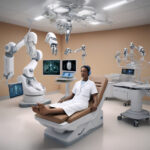In a recent blog post, Dario Amodei, the CEO of Anthropic, shared an ambitious vision for the future of artificial intelligence (AI), suggesting that we could see powerful AI systems emerging by 2026. Amodei asserts that these advanced systems could not only surpass human intelligence but also tackle complex tasks traditionally beyond the reach of machines, such as solving intricate mathematical problems and conducting advanced scientific experiments. This optimism presents a radical shift in how we understand technology’s role in various sectors, particularly in healthcare, where these capabilities could usher in breakthroughs that enhance human health and potentially extend lifespans significantly.
Amodei foresees a time when AI technologies could diagnose diseases with unparalleled accuracy and develop tailored treatments that significantly improve patient outcomes. For instance, AI’s capability to analyze vast amounts of medical data promptly can lead to early disease detection, thereby improving treatment efficacy. As a case in point, researchers at Stanford University have already demonstrated that AI can outperform radiologists in detecting lung cancer from CT scans. This kind of success story underscores the potential for AI to reshape healthcare systems globally.
However, not all voices in the discourse surrounding AI share Amodei’s optimistic stance. Critics highlight current limitations of AI, particularly its lack of independent thought and the prevailing difficulties in translating AI solutions into practical applications within the healthcare environment. They argue that while the dream of AI solving societal issues—such as hunger and climate change—sounds appealing, it requires more than just technological advancement. Achieving these lofty goals will necessitate robust global cooperation and a concerted philanthropic approach to ensure equitable access to AI benefits.
The concern for the socio-economic impact of AI is another layer to the discussion. Many experts warn of the significant job displacement risk as AI systems increasingly automate tasks traditionally performed by humans. Amodei acknowledges this risk but stops short of offering comprehensive strategies for the economic disruptions that could follow. He suggests that society will need to rethink its economic structures to adapt to an AI-filled future but provides little practical guidance on how to navigate these potentially turbulent waters.
Moreover, ethical considerations surrounding AI cannot be sidelined. The technology’s capacity for bias, privacy concerns, and the lack of accountability in decision-making processes raise pressing questions about how AI is developed and implemented. Such issues illustrate the dual-edged nature of this transformative technology—while AI can drive immense progress, it also possesses the potential to exacerbate existing inequalities if not managed responsibly.
In considering the potential benefits and challenges, Amodei envisions AI as a “transformative force for good.” However, skeptics remain cautious, emphasizing that the excitement around AI must be balanced with a clear understanding of the ethical dilemmas it poses and the economic realities it will challenge. The need for a framework that ensures accountability in AI deployment is paramount, as is the importance of fostering a public dialogue about the implications of such technologies on society.
As we look forward, Amodei’s predictions spotlight a pivotal crossroads in our relationship with technology. The potential for AI to revolutionize various sectors comes with the imperative to build safeguards that ensure its benefits are shared widely and equitably. A proactive approach that includes diverse stakeholder engagement, ethical standards, and educational initiatives will be essential to navigate the complexities of AI’s integration into our societies.
This unfolding narrative serves as a reminder that while technological advancements can propel us into an unprecedented era of opportunities, they require careful consideration to secure a future where innovation also aligns with the greater good.












